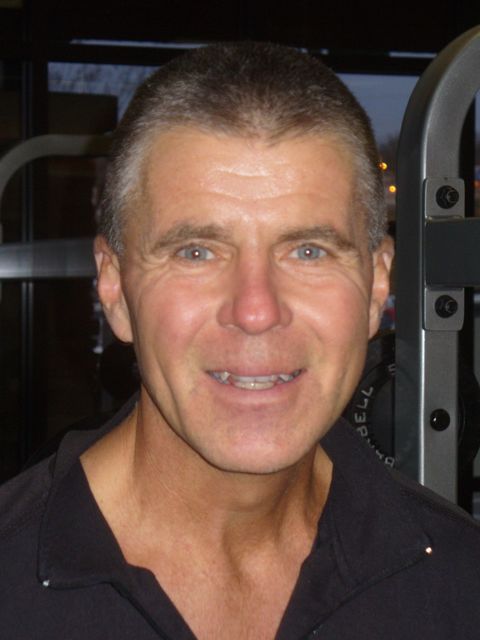
How many men do you know that are fifty-plus years old? Probably a good deal. Now: how many of those men were doing pushups at the age of three, working in the gym at the age of nine, are currently running a training center and working with S.W.A.T. teams, pro athletes, and other guys like that, and can do the ladder drill better than anyone around? “Well, a few.” Yeah, right. Anyway, that’s the kind of guy that I met with today. His name is “Coach” Tim Powers, and he has worked with over 200,000 different kids, improving their balance, durability, and flexibility: not only in training, but also in life as well.
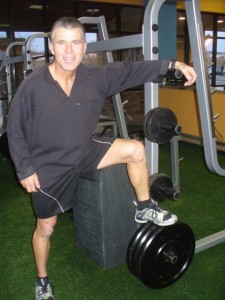 He is part of a team of trainers that run a gym here in town, so that’s where Dad took me. Coach Powers was busy when we came in, so we just kind of looked the place over. It was professional, yet it made you feel at home. There was lots of open space, but they had a lot of normal gym stuff as well. Then the coach came over, and we forgot about checking the place out. Coach Powers isn’t a big guy, but he fills the room with his high-octane energetic spirit. He said hello to Dad, who then left, and I got shown around the place. In the center of the gym was a mini football field, for footwork and ladder drills and things of that sort. Off to one side were the weight sets, the machines, and stuff for building your upper body. And in the back were various dummies (no, I wasn’t one of them, so don’t even go there) for kicking and punching practice. Coach didn’t have anyone to train until 4:30, so we had a little time to talk.
He is part of a team of trainers that run a gym here in town, so that’s where Dad took me. Coach Powers was busy when we came in, so we just kind of looked the place over. It was professional, yet it made you feel at home. There was lots of open space, but they had a lot of normal gym stuff as well. Then the coach came over, and we forgot about checking the place out. Coach Powers isn’t a big guy, but he fills the room with his high-octane energetic spirit. He said hello to Dad, who then left, and I got shown around the place. In the center of the gym was a mini football field, for footwork and ladder drills and things of that sort. Off to one side were the weight sets, the machines, and stuff for building your upper body. And in the back were various dummies (no, I wasn’t one of them, so don’t even go there) for kicking and punching practice. Coach didn’t have anyone to train until 4:30, so we had a little time to talk.
He told me that his dad was a frog man on a destroyer in the South Pacific (frog men, if you don’t know, were the original Navy Seals), and his mom was a devout Catholic. As a result of that, they mainly went to Catholic schools. Coach Tim started a life of working out at the age of three, when his father made him get down on the floor and showed him how to do pushups. His dad told him, “I want you to do these every day for the rest of your life.” He said okay, and that’s how he began. For Christmas, his dad welded together two ball bearings with a rod in between them and that was his first dumbbell. Make a few more with bigger ball bearings, and there’s your weight set. He used them, too. Even before he became a teen, he was doing Olympic-level drills in the local gym. But he wasn’t that big of a guy, and it was hard for him to compete with bigger guys. So he automatically started to lean toward training.
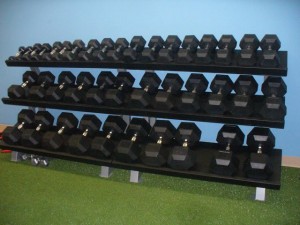 He was good at training, but he still wanted to compete in something, so he took up distance running. He was very dedicated in his training, and pretty soon he was running 140-160 miles a week. But one day, while running, Coach Tim felt a tug in his hamstring area. It didn’t hurt, so he kept jogging. The next morning, though, was a different story. When he tried to run, his hamstring got so tight he had to hitchhike back to his house. As it turned out, the cover for his nerve center near his hamstring had come off, so he had raw nerves in his leg. He couldn’t run for the next eight years. That was when he really started to get into the training side of athletics.
He was good at training, but he still wanted to compete in something, so he took up distance running. He was very dedicated in his training, and pretty soon he was running 140-160 miles a week. But one day, while running, Coach Tim felt a tug in his hamstring area. It didn’t hurt, so he kept jogging. The next morning, though, was a different story. When he tried to run, his hamstring got so tight he had to hitchhike back to his house. As it turned out, the cover for his nerve center near his hamstring had come off, so he had raw nerves in his leg. He couldn’t run for the next eight years. That was when he really started to get into the training side of athletics.
Coach Powers had been raised Catholic, but he had never really “gotten saved”. But in 1996, he accepted Jesus as his savior and became part of His family. A few years after that, God gave him a unique thought about working out; that a person should train to serve. What that means is that instead of me working out so I can get big, it’s He wants me to serve him by working out. That’s the whole “training to serve” idea. That’s why he coaches some people free; he’s just doing unto others like he wants them to do to him. And he’s seen the fruit of that labor.
After he was finished with his testimony, I got to ask a few questions about working in the sports and fitness arena. First, I wanted to know how much dedication it takes to compete in the big spotlight. He said that there are three things an athlete needs to get there and stay there, so to speak: humility, gratefulness, and dedication. For instance, there once was a football player who was always working, always learning, and always practicing. Even though he was good, he never thought he was a guru at the sport. In case you don’t know who I’m talking about, he was the greatest wide receiver ever to play in the NFL: Jerry Rice. He was always humbling himself by being eager to learn, even if it made him look stupid. And that’s why he was so good.
The next thing I asked the coach was what he thought the most dangerous sport in the world is. He said without hesitation that Australian-rules football and American football, are probably in the top five. However, he also said that because athletes are getting so much bigger and stronger, even “non-contact” sports like basketball and soccer are highly volatile these days. Another question I posed was whether or not kids my age should start working out right now. He replied that starting at age eleven, boys are getting their testostrone boost and it’s a good idea to start working out. However, it would be better to do things like pushups, pullups, situps, and things like that, instead of working with weights.
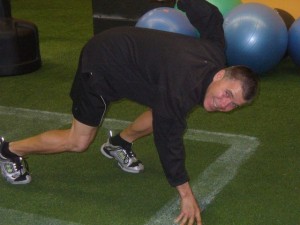 We had finished with our talk by about 4:20, and Coach Powers was supposed to have a kid about my age come in at half past, so he began getting ready. He set up some cones on the gridiron, as well as a ladder. Then, to get him going, we threw some football with a guy named Michael that Coach Tim works with. But four thirty came and went, and there was no sign of his student, so he decided to just give me the lesson. I was in bless (I don’t believe in luck), because that day the coach was focusing on balance and footwork, crucial parts of an athlete’s world. We started by doing a few ladder drills. Coach Tim would lead, Michael would go second, and I would bring up the rear. that way, I got to see it twice before attempting the drill. We began with the old one-foot-in-each-hole drill. Easy to watch–but not to do. Tim: hop hop hop hop done. Michael: bounce bounce bounce bounce done. Me: hop trip bounce slip fail. Next, we did in-and-outs. That’s where you alternate your feet in and out of the holes. Tim: patter patter patter patter done. Michael: chop chop chop chop done. Me: chop flop stop drop bomb. Actually, it wasn’t that bad, since it was my first time, but I’m going to need a whole lot more practice at that thing before I can beat it.
We had finished with our talk by about 4:20, and Coach Powers was supposed to have a kid about my age come in at half past, so he began getting ready. He set up some cones on the gridiron, as well as a ladder. Then, to get him going, we threw some football with a guy named Michael that Coach Tim works with. But four thirty came and went, and there was no sign of his student, so he decided to just give me the lesson. I was in bless (I don’t believe in luck), because that day the coach was focusing on balance and footwork, crucial parts of an athlete’s world. We started by doing a few ladder drills. Coach Tim would lead, Michael would go second, and I would bring up the rear. that way, I got to see it twice before attempting the drill. We began with the old one-foot-in-each-hole drill. Easy to watch–but not to do. Tim: hop hop hop hop done. Michael: bounce bounce bounce bounce done. Me: hop trip bounce slip fail. Next, we did in-and-outs. That’s where you alternate your feet in and out of the holes. Tim: patter patter patter patter done. Michael: chop chop chop chop done. Me: chop flop stop drop bomb. Actually, it wasn’t that bad, since it was my first time, but I’m going to need a whole lot more practice at that thing before I can beat it.
We did the ladder drills for about half an hour, and then we moved to the cones. These were arranged in an undulating line for running in and out of. But before we did any drills, Coach Tim showed me the proper mechanics a person should use while running. Always have your feet pointing straight out from your body, not out to the side. Don’t run on a tightrope; feet should be shoulder-width apart. And always keep your weight on the balls of your feet. Those are the main rules of good running posture.
The first drill that we engaged in was just the normal one where you run right through the cones, chopping your feet as you go. In the next drill, we started out sideways, and “came back” (went forwards), “dropped back” (went backwards), and slid sideways to get through the cones. There were a lot of variations we did out of that main drill, like going backwards, sliding one foot behind the other, and doing “chainsaw”, or not cutting the corners around the cones. While working, one of the things I noticed about the coach was that he would always tell you how to get better, while encouraging you at the same time. I don’t know how he did it, but it was effective. Another thing that stood out to me was the fact that Coach Powers would do the drill right along side of you. He might have been four times older than I was, but that didn’t stop him one bit. As a result, I respected him way more, and our session was more productive.
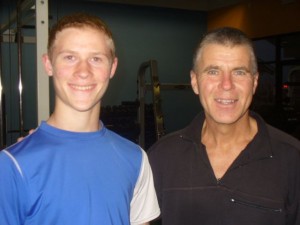 The time passed quicker than I thought it would, and my dad soon came to pick me up. We said our goodbyes, and left. But in the car ride home, my mind was literally whirling with all of the neat things I had learned: not only about fitness and posture, but about living your life for someone else, and not yourself. That aspect of life is one of the many things that define Coach Tim Powers, and one of countless reasons why I’m proud to call him my friend. So next time you stop by the gym for a workout, remember who you’re working out for; and be looking for ways to serve all throughout your day.
The time passed quicker than I thought it would, and my dad soon came to pick me up. We said our goodbyes, and left. But in the car ride home, my mind was literally whirling with all of the neat things I had learned: not only about fitness and posture, but about living your life for someone else, and not yourself. That aspect of life is one of the many things that define Coach Tim Powers, and one of countless reasons why I’m proud to call him my friend. So next time you stop by the gym for a workout, remember who you’re working out for; and be looking for ways to serve all throughout your day.